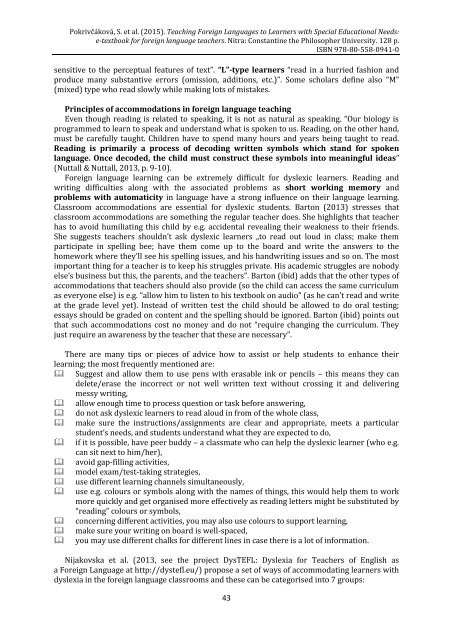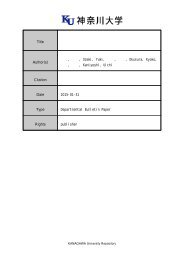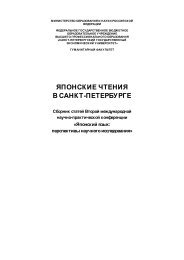to Learners with Special Educational Needs
e-textbook SEN
e-textbook SEN
You also want an ePaper? Increase the reach of your titles
YUMPU automatically turns print PDFs into web optimized ePapers that Google loves.
Pokrivčáková, S. et al. (2015). Teaching Foreign Languages <strong>to</strong> <strong>Learners</strong> <strong>with</strong> <strong>Special</strong> <strong>Educational</strong> <strong>Needs</strong>:<br />
e-textbook for foreign language teachers. Nitra: Constantine the Philosopher University. 128 p.<br />
ISBN 978-80-558-0941-0<br />
sensitive <strong>to</strong> the perceptual features of text”. “L”-type learners “read in a hurried fashion and<br />
produce many substantive errors (omission, additions, etc.)”. Some scholars define also “M”<br />
(mixed) type who read slowly while making lots of mistakes.<br />
Principles of accommodations in foreign language teaching<br />
Even though reading is related <strong>to</strong> speaking, it is not as natural as speaking. “Our biology is<br />
programmed <strong>to</strong> learn <strong>to</strong> speak and understand what is spoken <strong>to</strong> us. Reading, on the other hand,<br />
must be carefully taught. Children have <strong>to</strong> spend many hours and years being taught <strong>to</strong> read.<br />
Reading is primarily a process of decoding written symbols which stand for spoken<br />
language. Once decoded, the child must construct these symbols in<strong>to</strong> meaningful ideas”<br />
(Nuttall & Nuttall, 2013, p. 9-10).<br />
Foreign language learning can be extremely difficult for dyslexic learners. Reading and<br />
writing difficulties along <strong>with</strong> the associated problems as short working memory and<br />
problems <strong>with</strong> au<strong>to</strong>maticity in language have a strong influence on their language learning.<br />
Classroom accommodations are essential for dyslexic students. Bar<strong>to</strong>n (2013) stresses that<br />
classroom accommodations are something the regular teacher does. She highlights that teacher<br />
has <strong>to</strong> avoid humiliating this child by e.g. accidental revealing their weakness <strong>to</strong> their friends.<br />
She suggests teachers shouldn’t ask dyslexic learners „<strong>to</strong> read out loud in class; make them<br />
participate in spelling bee; have them come up <strong>to</strong> the board and write the answers <strong>to</strong> the<br />
homework where they’ll see his spelling issues, and his handwriting issues and so on. The most<br />
important thing for a teacher is <strong>to</strong> keep his struggles private. His academic struggles are nobody<br />
else’s business but this, the parents, and the teachers”. Bar<strong>to</strong>n (ibid) adds that the other types of<br />
accommodations that teachers should also provide (so the child can access the same curriculum<br />
as everyone else) is e.g. “allow him <strong>to</strong> listen <strong>to</strong> his textbook on audio” (as he can’t read and write<br />
at the grade level yet). Instead of written test the child should be allowed <strong>to</strong> do oral testing;<br />
essays should be graded on content and the spelling should be ignored. Bar<strong>to</strong>n (ibid) points out<br />
that such accommodations cost no money and do not “require changing the curriculum. They<br />
just require an awareness by the teacher that these are necessary”.<br />
There are many tips or pieces of advice how <strong>to</strong> assist or help students <strong>to</strong> enhance their<br />
learning; the most frequently mentioned are:<br />
Suggest and allow them <strong>to</strong> use pens <strong>with</strong> erasable ink or pencils – this means they can<br />
delete/erase the incorrect or not well written text <strong>with</strong>out crossing it and delivering<br />
messy writing,<br />
allow enough time <strong>to</strong> process question or task before answering,<br />
do not ask dyslexic learners <strong>to</strong> read aloud in from of the whole class,<br />
make sure the instructions/assignments are clear and appropriate, meets a particular<br />
student’s needs, and students understand what they are expected <strong>to</strong> do,<br />
if it is possible, have peer buddy – a classmate who can help the dyslexic learner (who e.g.<br />
can sit next <strong>to</strong> him/her),<br />
avoid gap-filling activities,<br />
model exam/test-taking strategies,<br />
use different learning channels simultaneously,<br />
use e.g. colours or symbols along <strong>with</strong> the names of things, this would help them <strong>to</strong> work<br />
more quickly and get organised more effectively as reading letters might be substituted by<br />
“reading” colours or symbols,<br />
concerning different activities, you may also use colours <strong>to</strong> support learning,<br />
make sure your writing on board is well-spaced,<br />
you may use different chalks for different lines in case there is a lot of information.<br />
Nijakovska et al. (2013, see the project DysTEFL: Dyslexia for Teachers of English as<br />
a Foreign Language at http://dystefl.eu/) propose a set of ways of accommodating learners <strong>with</strong><br />
dyslexia in the foreign language classrooms and these can be categorised in<strong>to</strong> 7 groups:<br />
43






